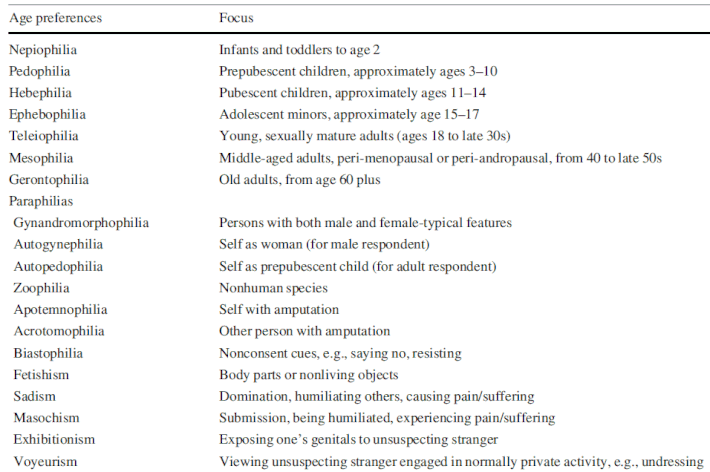
Quick, what is sexual orientation? If you’re like most people, you probably answered something like “Whether you are attracted to men, women, or both.” That’s understandable, but you only get partial credit. But given the current scientific understanding of what sexual orientation is — that it is a deep-seated attraction toward certain sorts of people that first manifests itself around puberty, tends to be stable across the lifespan, and can’t be altered by any intentional means — there’s compelling reason to think gender is just one piece of a bigger, more complex puzzle.
That’s the point hammered home in a new article in a special issue of the journal Archives of Sexual Behavior dedicated to the puzzle of sexual orientation. Written by Michael C. Seto, the forensic research director at the Royal Ottawa Health Care Group, the article focuses particularly on what are known as chronophilias, or sexual orientations which target certain age groups (the article is paywalled, but Seto said anyone who wants a copy can contact him via email or Twitter).
“One of the things I’m hoping to do in this paper is to point out what a huge frontier chronophilias are,” he told Science of Us via DM. That’s part of his broader attempt to expand the boundaries of sexual orientation as a concept, in light of research from him and others suggesting other dimensions matter as well. Are you aroused by others or by yourself? By living people or dead ones? And, most importantly from the point of view of criminological and forensics work, by older people or younger ones?
One of Seto’s biggest contributions to this field, so far, has been to argue that pedophilia should be considered a sexual orientation. It’s vital to point out that categorizing something as a sexual orientation does not mean that acting on it is morally acceptable. When the subject of expanding the boundaries of sexual orientation comes up, people tend to draw sloppy analogies between pedophilia and homosexuality, for example, arguing that lumping them together under the rubric of sexual orientation either excuses pedophilia or kneecaps moral arguments for gay rights. But what matters is whether the pursuit of sexual gratification harms other people — pedophilia does, homosexuality doesn’t. It’s worth a bit of confusion here for the key insight that this model provides: In all these cases, despite how morally different they are, the preferences in question weren’t chosen and can’t be altered (except in rare cases where they seem to shift over the course of a lifespan for reasons no one can fully explain).
There’s a chart in Seto’s paper (larger version here) that offers a helpful rundown of what the broader sexual-orientation model might look like if this view becomes more firmly established among sex researchers:

The top terms are the words used to describe attraction to various age groups. The bottom terms are paraphilias, meaning — to oversimplify a bit — sexual urges that researchers find unusual and which seem to pop up a lot. “Where we are on safe ground with gender, I am making an argument for age” to be considered a sexual orientation, explained Seto, “and maybe some day we’ll have a better understanding of how other paraphilias fit in.” This will depend on empirical research, of course: Not just any common sexual interest is an orientation. It has to fit the aforementioned criteria about intensity, development at puberty, stability over the lifespan, and so on.
If you haven’t heard the above term “mesophilia” before, that’s because Seto created it to to refer to people who are attracted to middle-aged individuals. “I think nobody has studied mesophilia yet because it’s not seen as a pressing need clinically,” Seto explained. In other words — and this is a point he makes in his paper as well — if a mesophile goes about searching for sexual gratification by casing the local Target for dads who are down, it doesn’t put anyone at risk of harm (homewrecking aside) or lead to lawbreaking in the way a pedophile searching for victims does. So because of the lack of research interest in mesophilia, Seto is inferring the existence of this orientation rather than pointing to an established literature on it.
But logically, it’s extremely likely mesophilia is real. One compelling reason to believe in it is that there is clinical evidence to suggest sexual orientations directed toward every other age range, from nepiophilia all the way up to gerontophilia (though for the aforementioned reasons researchers have exhibited far more interest in pedophilia than gerontophilia). Why would there be a gap for middle-aged people? Another piece of evidence is — ahem — pornography. While ever-popular MILF and DILF videos tend to focus on men and women who are actually in their 30s and therefore not in the preferred age range of mesophilia, Seto writes, so-called “granny” videos and their ilk, on the other hand, do tend to feature performers in their 40s and 50s. The fact that a lot of these videos get made suggests there is a market for them, which adds some weight to the case for mesophilia (though people with one orientation can certainly dabble in pornography or sexual activities associated with another).
So what would it mean for someone to be a mesophile? Simply that they have a deep-seated attraction to middle-aged people. If what researchers have found out about other sexual orientations holds here, and there’s no reason to think it wouldn’t, this might partly be attraction that keys in on certain physical features — perhaps mesophiles are into the paunches many men develop in middle age, or to women’s breasts that have begun to visibly sag — and partly a story mesophiles tell to explain their attraction. Whereas some pedophiles talk about being attracted to kids’ levels of innocence and similar qualities, for example, Seto writes that he would “expect that mesophilic and gerontophilic individuals would emphasize qualities such as wisdom, maturity, and experience as a part of what they find attractive about middle-aged and elderly persons, respectively.”
Other aspects of sexuality likely hold for mesophiles, too. As Seto notes elsewhere in the paper, just because someone is attracted toward one sort of person doesn’t mean that, in certain situations, they aren’t attracted to, or don’t engage in sexual relations with, others. The vast majority of people are teleiophiles, for example, meaning they are most attracted to young, sexually mature adults in their late teens to early 30s. That doesn’t mean that they only have sex with people in that age range. Sometimes teleiophiles only have access to people who are older; sometimes there are Harold and Maude situations where a young person falls in love with a much older one; and sometimes straight men have sex with other guys. Also, there’s clinical evidence that people can have multiple orientations along the same dimension. The clearest example is bisexuality, but there are also (rare) cases in which pedophiles are also gerontophiles, for example. So theory suggests that usually a mesophile will be primary attracted to middle-aged people, but there could be some who are also attracted to other age ranges as well.
While Seto doesn’t have plans to depart from his long-term interest in better understanding attraction to infants and pubescent children, he said that there’s a ton of untapped potential for researchers to examine sexual attraction toward other, less morally and legally fraught age ranges. “One of my hopes with this paper is to encourage people to look at mesophilia,” he said. The world’s many connoisseurs of granny porn likely agree.




